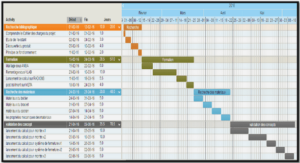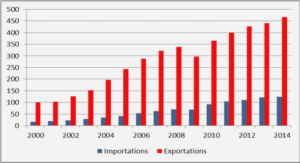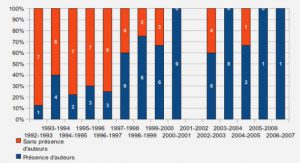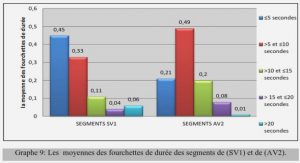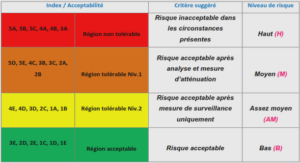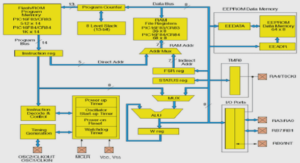Télécharger le fichier pdf d’un mémoire de fin d’études
SCOPE AND LIMITATION OF THE WORK
Because of the broad possibilities of drama, we had to limit the scope of our work on studying modern American plays written after the WWII by WILLIAMS: “A Streetcar Named Desire” and “Sweet Bir d of Youth”.
Now we will study about the writer and his works; and end this subsection with the limit of the work. Tennessee WILLIAMS (26 March 1911- 26 February 1983). He was a Southerner American playwright. He grew up in Mississippi, also called as the Deep South. Most of his works depict social American life in the South. WILLIAMS dominated American theatre in the middle year of the twentieth century. He was known through his “plastic theatre” . The theatre, which involved the use of lights, music, sets; and any other forms of non-verbal expression that, would complement the textual version of the play.
Indeed, WILLIAMS won an array of honours thanks to his plays which have a quality of verisimilitude and plausible in performance. Ester M. JACKSON, in The American Theater (1957) confirms “ Tennessee WILLIAMS was the first to earn the descriptive title of “pop ular dramatist”. Tennessee WILLIAMS wrote many plays; and among them “A Streetcar Named Desire” and “Sweet Bird of Youth”.
“A Streetcar Named Desire” written in 1947 was one of His major plays. It was his best and it ran for 855 performances. The play ran for fifty years and it is still broadcasted on TV even nowadays. Londré HARDISON, in The Cambridge Companion to Tennessee WILLIAMS (1997) says that “ the latter production of this play appeared on CBS television broadcast on October 29, 1995 with Jessica LANGE and Alec BALDWING as staring” 1. The same play was broadcasted on MATV and RTA-TAMATAVE in 2004.
On the other hand, WILLIAMS gained also his reputation with “Sweet Bird of Youth” which appeared in 1962. Equally, thi s play was turned into film.
The two plays were among the ten plays, which have been turned into films.
In this work, these two plays are suggested for they are still seen and read nowadays; and they are modern. Despite the lack of time devoted for the learning of English, it is not possible to use the whole plays with the students. Therefore, we have to work on some dialogues excerpts from them. Since dialogues can be used to improve a variety of language skills and elements, as a result, we limited the use of the extracts from plays to practise language functions. As the latter is studied at lyceé, in the three levels, then we will do our experimentations in these three levels.
Normally, the teaching and learning of the language functions should not be separated from its components: grammar, vocabulary and pronunciation. We cannot deal with all of these subskills for the time is limited. We will concentrate then our studies on the functions only. This does not mean that we will neglect the other subskills; they will be taken into consideration but not in depth.
In overall, we have to limit our work on dramatizing dialogue excerpts taken from “A Streetcar Named Desire” and “sweet Bi rd of Youth” during class hours to practise language functions; and this dialogue-dramatization will be put into experiment in all the three levels at lycée.
STRUCTURE OF THE WORK
This dissertation will be divided into three main parts. In the first part, we will try to deal with the theoretical aspects of the subject. The second one will be focussed on giving clearer assessment of the situation of the subject at lycées; and reporting and commenting the experimentations. The last part will examine the possible solutions to the improvement of the language functions by means of plays and broadening the perspectives. Clearly, the finding will be splitted into three great distinctive parts.
PRESENTATION OF THE PLAYS
In order to help the readers to follow the progress of this work, it is worth if we present the masterpieces at the beginning of the study.
TITLE: A STREETCAR NAMED DESIRE
DIVISIONS OF THE PLAY: Eleven scenes
THE WRITER: TENNESSEE WILLIAMS
ISSUED: 1947
SCENE: At ELYSIAN FIELDS/ New Orleans
CHARACTERS:
– Blanche DUBOIS Stella’s grand sister
-Stella KOWALSKI Stanley’s wife
-Stanley KOWALSKI Blanche’s brother-in-law
-HAROLD MITCHELL (Mitch) Stanley’s friend
-Eunice HUBBEL Steve’s wife
-Steve HUBBEL Stanley’s neighbour
-Pablo GONZALES Stanley’s friend
-Negro woman Stella’s neighbour
-A strange woman (nurse)
-A strange man (doctor)
-A young collector
-A Mexican woman
SUMMARY:
Blanche DUBOIS visited her sister Stella who lives in New Orleans near the stop of the streetcar named desire with her British husband Stanley KOWALSKI. Blanche has an appearance of ladylike grace and constantly refers to her early life at the family estate of Belle Rêve. Bewildered by her new environment and by the antagonism of her brother-in-law, she turns to his friend Mitch for consolation and company. Stanley, however, learns that Blanche is not the Southern Belle Rêve. She purports to be and tells Mitch that she is in fact a lonely alcoholic who has been forced into bankruptcy and who has lost her job because of an affair with a young boy who reminded her of her dead husband. Blanche’s antagonistic relationship with Stanley culminates in his raping her. She tells Stella but Stella does not believe her and at the end of the play, she is taken into psychiatric care.
TITLE: SWEET BIRD OF YOUTH
DIVISIONS OF THE PLAY: ACT ONE: Two scenes, ACT TWO: Two scenes, ACT THREE
THE WRITER: TENNESSEE WILLIAMS
ISSUED: 1962
SCENE: HOTEL IN SAINT CLOUD
CHARACTERS:
-Chance WAYNE
-The Princess KOSMONOPOLIS
-FLY
-MAID
-George SCUDDER
-HATCHER
-Boss FINLEY
-Tom JUNIOR
-Aunt NONNIE
-CHARLES
-STUFF
-Miss LUCY
-The HECKLER
-VIOLET
-EDNA
-SCOTTY
-BUD
-Men in bar
SUMMARY:
Drifter Chance WAYNE returns to his hometown after many years of trying to make it in the movies. With him is a fade film star he picked up along the way, Alexandra DEL LAGO. While trying to meet his former girlfriend Heavenly, the daughter of the local politician Tom Boss’ FINLEY, who more or less forced him to leave the town many years ago.
PART ONE: THEORETICAL CONSIDERATIONS
GENERAL NOTIONS ON DRAMA
DEFINITIONS OF DRAMA
* In the COLLINS ENGLISH DICTIONARY (1991), drama is from drÃn, which means, “to do”. It is the genre of lite rature represented by works intended for stage.
* THE WORLD BOOK ENCYCLOPAEDIA (1994) defines the word drama as an art form that tells story through the speech and actions of the characters in the story.
Some writers try also to define the term drama in their works:
* Keith JOHNSON and MORROW (1981), Drama is a convenient umbrella term for activities, which involve an element of let’s pretend .
* WESSELS (1987), Drama is being. Drama is doing. Drama is such a normal thing. It is something that we all engage in daily when faced with difficult situations.
* Sally MACKEY and Simon COOPER (2000), drama is a performed art. It is a combination of text, production and reception.
* According to Richard VIA as quoted log wilga Rivers (1983) in communicating naturally in a 2nd language, Drama is all communication.
* M.H.ABRAMS (1985), Drama is the form of composition designed for performance in the theatre in which actors take the roles of the characters, perform the indicated action, and utter the written dialogue.
These definitions show that drama is a complex word and it is not easy to define it. These definitions enumerated above are not contradictory. Rather, they are complementary. However, for the sake of this research, we will take into consideration the two last descriptions of Drama stated by VIA and M.H.ABRAMS for they are simple, complete and clear.
In one word, Drama then includes communication, performance, theatre, actors, characters, actions and dialogues.
Drama in some form can be found in every society, country. Therefore, it is worth knowing its origin.
ORIGIN OF DRAMA
No books give the exact date of the birth of drama; and most writers agree with the fact that drama was born in Greece. It had its root in primitive religious ritual. This cult existed long time ago in Egypt; and later on, this rite was imported to Greece by trade route. The Egyptian drama was based on the worship of the god Osiris; and that of the Greek on the god Dionysus “Dramas” was a name suggested by Egyptologists to t he Pyramid texts written on the inside walls of the pyramids in 1882. Although the cult, which constituted drama, originated in Egypt, drama did not develop there but in Greece. This explain the reason why many authors said that drama was born in Greece because there was held the first theatrical event of the world; and this great Dionysian festival made known THESPIS as the first outstanding playwright in the world. He was called “ the father of drama.”
Many years after, Greek drama reached its epic; and this thanks to these three tragic playwrights: AESCHYLUS, SOPHOCLES, and EURIPIDES; and the greatest comic playwright ARISTOPHANES.
This Golden age of Greek drama influenced all drama around the world; and this evolution of the ancient Greek drama reached the American continent.
EVOLUTION OF DRAMA
According to its history, the British people colonised the Americans. These colonists then imported Drama in that continent. As a result, American theatre started around 1750 in the North of America The first professional American playwright was William DUNLAP. From then on, Drama develops all over the USA.
Anyway, some critics point out that the real history of American Drama started with the rise of Eugene O’ NEIL in 1916. He was considered as the first outstanding American playwright He dominated the American Drama of the World War I. Later on, American drama knew some crisis and Eugene O’NEIL was succeeded by two greatest playwright: Tennessee WILLIAMS and Arthur MILLER who dominated the American drama of the post-world war II. Their works influenced many writers of the years after. Concisely, American Drama was modelled on British Drama; then it spread all over the states.
In this dissertation, drama is not used as a show or a recreation which is aimed at making fun or theatrical performance. Yet, it is employed in the language classroom during the class sessions to improve the practice of language functions. Now then, we are going to study the utility of drama in the language classroom.
DRAMA IN THE LANGUAGE CLASSROOM
Drama in the language classroom provides good techniques which can help the teachers to achieve some goal in the teaching and learning of English as a foreign language. In the language teaching for example, drama provides plays (drama texts) as teaching aids which are worth exploiting at school for they are visual aids and authentic materials. Consequently, they work well with the students.
On the other hand, in the language learning, drama provides activity such as a dramatization which is an effective activity which enable the students to learn in more dynamic, enjoyable and fruitful ways.
This last paragraph leads us to consider the study of dramatization in the language classroom.
DRAMATIZATIONS IN THE LANGUAGE CLASSROOM
Etymologically, Dramatization derives from “drama” plus the suffix “-ion” which implies an action. It means then the act of dramatising a play or a novel in front of the audiences.
Dramatization can be defined as the reconstruction of an event, novel and story in a form suitable for dramatic presentation.TW (1984)
Dramatizations as a dramatic activity can achieve many things in the language learning.
To begin with, dramatizations involves both saying and doing, seeing and listening. By saying, students can improve their oral English; and by doing, the students learn to move by using body language. The facts of seeing something help the learners to grasp the meaning of some words or expressions and to see the mood or the feeling of the actors. Dramatizations can improve the learners aural English for they have to listen carefully to what his/her interlocutor says. To add to that, learning by doing enables the students to speak loudly and to improve their reading.
Moreover, Dramatizations can foster group work and create good relationships within the learners. They can create an atmosphere of relaxation.
Furthermore, learning by doing enable the students to use the language in direct and straightforward ways with gestures and facial expressions.
Lastly, learning by doing stimulate real life situation in English. It helps the learners to come out of their shell.
Dramatizations in some ways require lots of time, place and sophisticated costumes to make the show successful. Are these things necessary in the dramatizations during class sessions?
DRAMATIZATIONS DURING CLASS SESSIONS
Since dramatizations can achieve many things in the language classroom; therefore, it is undeniable that dramatizations can be used in everyday lessons to attain some goals. However, despite the lack of time devoted to the teaching of English, the size of the classroom and the lack of materials to be employed then it is not possible to make the dramatizations perfect.
Anyway, they can be adapted to suit the learning during the class hours. We mean by adaptation, the perfection of stage equipment such as light, instruments and decorations are not needed. BRIGHT, J.A. (1982) asserts that in the language classroom, “ no elaborate or sophisticated props and costumes are required”.
Students can use their imagination and all the props they see in the classroom. They are not obliged to wear all those sophisticated and aesthetic costumes. For instance, they can use a pen as a cigarette, a uniform as a towel. Let us remember that the aim here is not for theatrical performance but for improving the learning of language functions.
Alike, dramatizations in everyday lessons require lots of psychological preparation, imagination and organization. The students should be well-prepared mentally and physically; and they should be well-organized. These preparations require lots of time. As a conclusion, dramatizations can be adapted to fit the learning of the language during the class sessions.
Dramatizations and role-plays are both dramatic activities, but they are very different in some ways.
|
Table des matières
INTRODUCTION
PARTIE I :APPROCHE THEORIQUE
Chapitre I : CARACTERISTIQUES DU MONDE RURAL
Section1 : Concept et analyse du développement rural
1) Les différentes théories du développement
1.1 Approche orthodoxe
a)La théorie du dualisme
b)La théorie réformiste
1.2 Approche des différents organismes internationaux
2) Le développement et les indicateurs de développement
2.1 Définition
2.2 Les indicateurs du développement
3) Approche théorique du développement rural
3.1 La théorie de ROSTOW et des physiocrates
3.2 Les indicateurs et la place du développement rural
3.3 Les objectifs du développement rural
3.4 Dynamique du monde rural à travers les données économiques et sociales
a) Situation démographique
b) Situation sectorielle
c) L’économie rurale
d) Les infrastructures
e) La situation politique
Section2 : L’environnement malgache
1) L’environnement et le développement
1.1 Concept de l’environnement
1.2 Concept de développement durable
a)Définition
b)Les différentes approches du développement durable
2) L’importance de l’environnement à Madagascar
2.1 L biodiversité
2.2 Les caractéristiques de l’environnement
3) La place de l’environnement dans les théories économiques
3.1 L’économie de l’environnement
3.2 Evaluation de l’environnement
4) Les politiques environnementales
4.1 Les instruments économiques
4.2 Les instruments non économiques
Chapitre II :ETUDE STRATEGIQUE DU DEVELOPPEMENT RURAL ET LES PLANS D ACTIONS ENVIRONNEMENTALES
Section1 : Analyse des stratégies en faveur du développement rural
1) Les fondements d’une réforme rurale
1.1 L’utilité d’une réforme rurale
1.2 Les composantes stratégiques
1.3 Elaboration d’une politique agricole
1.4 La politique agricole de Madagascar
2) Les axes stratégiques opérationnels
2.1 Au niveau local
2.2 Au niveau national
Section2 : Processus de mise en oeuvre
1) L’étendue des projets et programmes
1.1 La lutte contre la pauvreté : le DSRP
1.2 La gestion du territoire : la décentralisation
1.3 La protection de l’environnement : la PAE
1.4 Le programme d’action pour le développement rural : le PADR
2) Les principaux acteurs du développement rural
2.1 Les ministères centraux
2.2 Les institutions et organismes Etatiques
Section3 : La politique environnementale
1) Problématique de la dégradation
1.1 La défaillance du marché
1.2 Les causes de la dégradation
a)Les facteurs naturels
b)les pratiques traditionnelles
c)les facteurs politiques
2) Mise en place de la politique environnementale
2.1 Les objectifs stratégiques des PAEs
2.2 Les différentes composantes du PAE
CONCLUSION
PARTIE II : LES INCIDENCES DU DEVELOPPEMENT RURAL SUR L’ENVIRONNEMENT
INTRODUCTION
Chapitre I : LES ENJEUX DE L’ENVIRONNEMENT
Section1 : L’environnement et le développement rural
1) Les potentiels de l’environnement
1.1) Le sol
1.2) Les atouts touristiques
1.3) Les ressources en eau
1.4) Les ressources minières
1.5) Le milieu, marin et les zones côtières
2) Les potentialités du secteur rural
2.1) L’agriculture
2.2) La filière riz
2.3) Les autres cultures
Section2 : Les obstacles majeurs
1) La pauvreté à Madagascar
1.1) Les milieux ruraux
a) Les us et coutumes
b) Mode de production
c) Le cadre juridique
1.2) La pauvreté et l’environnement
a)Le milieu naturel
b) Le milieu humain
2) La population et le développement humain : les propositions de réformes
2.1) Sur le plan économique
2.2) Sur le plan sectoriel
2.3) La protection de l’environnement
Chapitre II : ANALYSE EMPIRIQUE DES RESULTATS AU NIVEAU DE PROGRAMMES D’ACTIONS
Section1 : Bilan et évaluation des politiques établies
1) Les programmes et leur réalisation
1.1) Sur le milieu rural
a) L’agriculture
b) Le riz
c) L’élevage et la pêche
1.2) Les stratégies de réformes
a) Les infrastructures économiques et sociales
b) L’aide publique au développement
2) Les actions entreprises pour la protection de l’environnement
2.1) La politique forestière
2.2) Les aires protégées
2.3) La pollution
2.4) Réforme institutionnelle et politique
Section2 : Constat des lacunes
1) Au niveau de l’élaboration
1.1) Processus de planification
1.2) Les principaux promoteurs et acteurs
1.3) L’implication des paysans
2) Au niveau des comportements des paysans
3.1) Décaissement
3.2) Mécanisme de financement
3.3) Les projets entrepris
3) Au niveau du financement
3.1) Décaissement
3.2) Mécanisme de financement
3.3) Les projets entrepris
4) Au niveau de la mise en oeuvre des programmes et au niveau économique
4.1) Vulgarisation des données
4.2) Les résultats des recherches délaissés
4.3) Au niveau économique et institutionnel
Section3 : Suggestions et perspectives d’avenir
1) Les attributions du pouvoir public et le devoir des citoyens
1.1) Le rôle de l’Etat
a) Sur le plan politique
b) Sur le plan technique
c) L’investissement
d)Sur le plan social
1.2) Le rôle des citoyens
a) Au niveau de la réalisation des programmes
b) Au niveau psychologique
c) Vision future et l’expérience
2) Les mesures nécessaires pour l’environnement
2.1) Utilisation des instruments fiables
2.2) Suivi et évaluation
a) Pour les intervenants
b) Au niveau des CTDs
3) L’exemple des autres nations
3.1) Système de réglementation
3.2) Politique et programmes
CONCLUSION
RESUME ANALYTIQUE
BIBLIOGRAPHIE
ANNEXE1
ANNEXE
ANNEXE3
Télécharger le rapport complet

